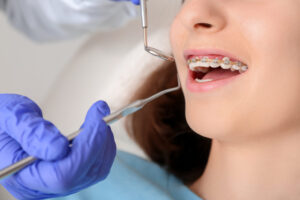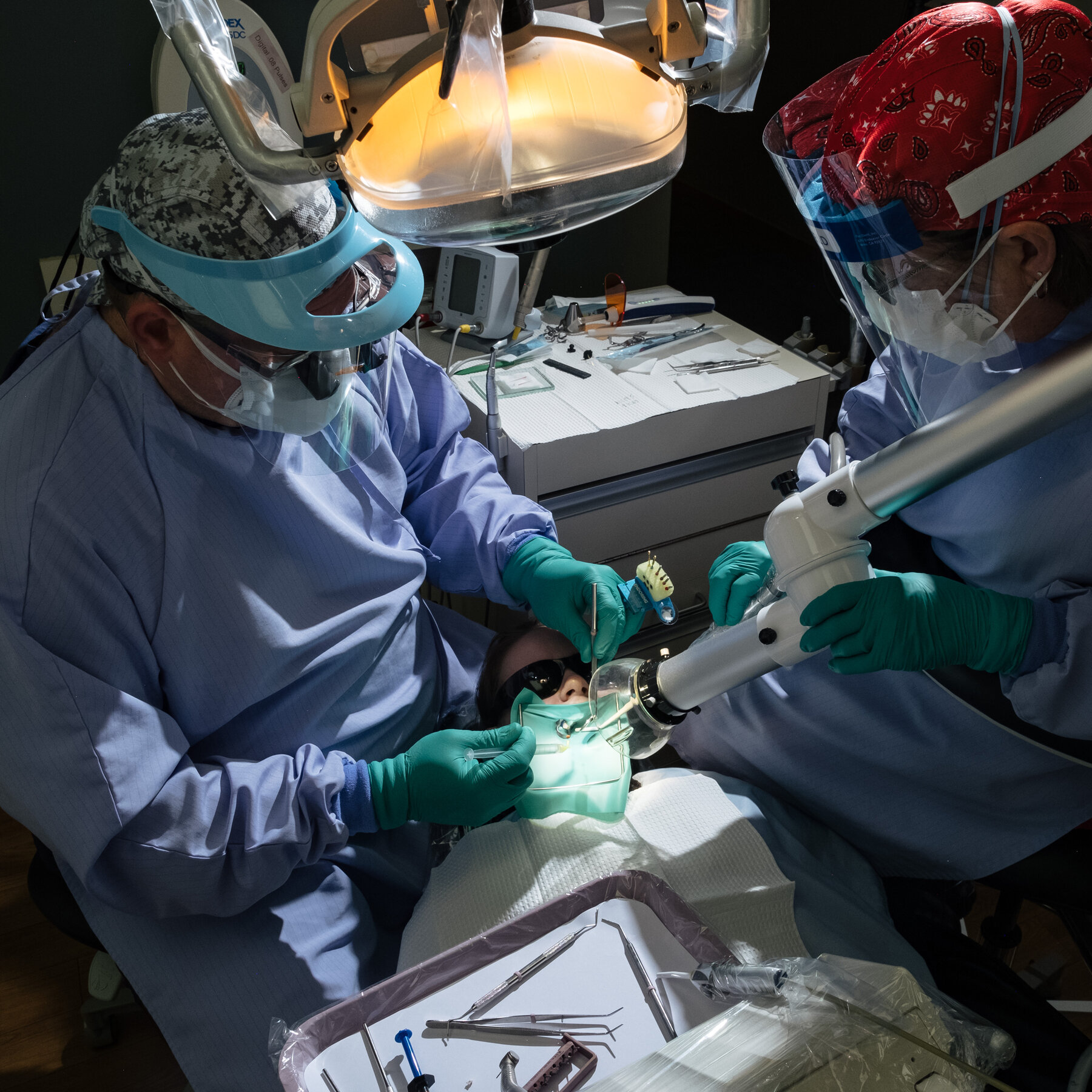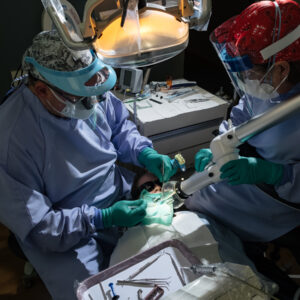During your first appointment, boca Dental and Braces will shave and lightly air-dry the surface of your teeth. A bonding agent is then applied, and the brackets (small metal squares) are glued to the front of each tooth.
Small rubber bands or elastic bands (in many fun colors) are placed around the back molars to help close spaces and apply pressure to the teeth.

Brackets are small pieces of metal that attach to each tooth. They come in different shapes and sizes, with some having hooks for rubber bands or elastic ligatures. After the orthodontist places each bracket on your teeth, she will use blue light to harden the glue. You may feel slight discomfort during this time.
The orthodontist will then attach an archwire to the brackets. This will apply constant pressure to the teeth, helping them move in the desired direction. The wire also helps adjust the palate and cheek of the mouth as the teeth shift. The archwire is made from either stainless steel or nickel-titanium. It can be tightened or loosened at various times during treatment to affect the movement of the teeth.
Some patients may need additional support during treatment, such as spacers or coil springs. These add extra pressure to the teeth and help create space for the molars in the back of the mouth.
While you are wearing your braces, it is important to eat a well-balanced diet. You should avoid sticky or hard foods, as they can get stuck in your braces and cause pain. Drinking plenty of water is also a good idea, as it will help rinse away food particles and debris.
Although you may initially experience some soreness, it is a sign that the teeth are beginning to realign themselves. By following the recommendations from your orthodontist, you can minimize this discomfort. If you feel pain, over-the-counter ibuprofen (Advil or Motrin) and a regimen of salt water rinses can help ease the discomfort.
Initially, when the braces are first put on, a light wire will apply only weak forces. This allows the soft tissue between your teeth to become accustomed to gentle pressure.
This malleable tissue, called the periodontal ligament, can reshape itself with controlled force. This is what helps move the teeth into their correct positions. When the archwire is attached to the brackets, it exerts a controlled and consistent force on the teeth. This constant force slowly repositions the crooked teeth into their proper positions.
The arch wires are made from a variety of materials. Stainless steel is typically used because it is sturdy and durable but not too hard. Some alloys have been created specifically for orthodontic use. These metal alloys provide added strength, durability, and elasticity to the archwire.
Your orthodontist may switch between different types of archwires based on the stage of treatment you are in. They will also change the thickness of the wire. Thicker wires apply more force than thinner ones.
It is important to avoid foods that can stick to your brackets or pull on the archwire. Sticky foods like gum, taffy, and other chewy candies can pull on the wire and cause it to deform. Very hard or crunchy foods can also break parts of the archwire or pull on the brackets.
If a part of your archwire breaks or becomes protruding from one of the brackets, you should save it and contact us. We will schedule an appointment to replace the broken wire or re-tighten the loose bracket. A loose or broken archwire can irritate the inside of your mouth and cause mouth sores. Sometimes, the fractured wire can even cut into your cheek or lip. If this happens, rinse your mouth with salt water to reduce the irritation.
Rubber bands are essential to the braces system, applying pressure to reposition the teeth and jaws. They come in various colors that help kids stay engaged with their orthodontic treatment. They also exert the right force on teeth and jaws to correct malocclusions. Not wearing them can prolong treatment, so they must be worn consistently.
They attach to the brackets using small metal hooks. They can be positioned differently on the teeth and broken into classes based on their function. Class 1 elastics are horizontal and close gaps between the upper and lower teeth. In contrast, class II elastics connect from the lower first molars to the upper canine, which helps correct overbites. Class III elastics reduce an underbite by shifting the upper and lower jaw backward to align the teeth, while front cross elastics hold the teeth together for midline alignment.
The elastics are made of latex, but we carry non-latex elastics for those with latex allergies. They are safe to eat with but should always be replaced immediately after eating as they will loosen and break if not removed right away. Your Peabody orthodontist will teach you how to place the elastics properly, and a plastic hook may be provided to help you identify them correctly if necessary.
It would be best not to let the elastics get too loose, as this can cause your bite to shift and create a new malocclusion. Your orthodontist will monitor the progress of your orthodontic treatment and will replace the elastics as necessary.
Elastics are rubber bands that help adjust bite misalignment. They can also close gaps between teeth, straighten crooked teeth, and help with tongue protrusion or an open bite (which causes your front teeth not to touch when chewing and can lead to a lisp). These elastics are usually placed around small hooks on the brackets. Your Peabody orthodontist will determine the direction, size, and force of the elastics needed to correct your specific problem.
When placing the elastics, standing in front of a mirror is helpful to make sure you can see what you’re doing. For those who have trouble pinching the elastics with their fingers, your orthodontist may provide a plastic hook to help you place them. You should wear the elastics at all times except when you are eating or brushing your teeth. The elastics must be worn consistently, as removing them too often can halt progress. You should always have fresh elastics on hand; if the old ones are stretched or broken, they will not apply the necessary amount of pressure to your teeth.
It is a good idea to bring a container with you to store your elastics in. This will keep them clean and prevent bacteria from building up. Carrying spare elastics with you is also recommended in case of breakage or loss. You should also avoid eating acidic foods when wearing elastics, which will cause them to deteriorate more quickly. Lastly, it would be best if you tried to change the elastics throughout the day, as this will ensure that they provide consistent pressure on your teeth and jaw.
Power chains are elastic chains that replace the ligatures (the rubber bands) used between brackets. They provide added pressure to close gaps between teeth, which can help correct malocclusions caused by childhood habits like thumb-sucking or tongue thrashing. They are usually placed on the back molars, which are more pressure-resistant than the front teeth.
There is no one-size-fits-all setting for power chains, as different patients have unique issues to resolve. The spacing between links on the power chain varies, and different diameters of each loop’s center control which bracket it fits onto. There are three different types of power chains, and within each type, there are several more options. Typically, your orthodontist will recommend closed power chains, as these fix at every bracket (no space between the rings).
We often use separators to make room for a band between the back teeth, then place a power chain on top of them. This allows us to put more pressure on the teeth and helps speed up treatment.
Power chains can be slightly more uncomfortable than traditional elastics because they pressure the teeth more. However, they do not cause more pain than other orthodontic treatments. As with any adjustment, there may be soreness for a few days after the orthodontist applies and adjusts power chains.
Since power chains can trap more food particles than elastics, you must be extra diligent about your oral hygiene routine. This will include brushing more regularly and spending a bit more time flossing to avoid food getting stuck in the ties between your teeth. Also, be sure not to eat hard or sticky foods that can cause the ligatures or brackets to break, which will delay your treatment and require extra appointments. To ease discomfort, you can take over-the-counter acetaminophen, such as Tylenol, as directed.


